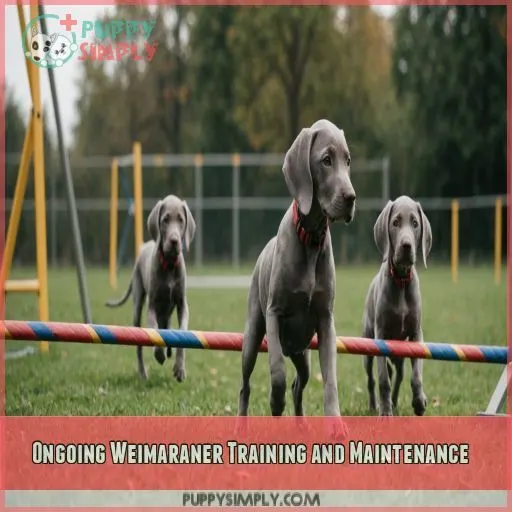This site is supported by our readers. We may earn a commission, at no cost to you, if you purchase through links.

Begin by socializing your pup between 8-16 weeks, focusing on positive reinforcement techniques like treats and praise. Set boundaries and expectations, and be consistent – Weimaraners thrive on routine.
As you progress, you’ll address behavioral traits like separation anxiety and destructive behavior. With patience and the right strategies, you’ll be well on your way to raising a happy, well-behaved companion.
But, what’s the best way to structure your cluster training sessions?
Table Of Contents
- Key Takeaways
- Weimaraner Puppy Training Basics
- Addressing Weimaraner Behavioral Traits
- Creating a Training Schedule for Weimaraners
- Exercise Needs of Weimaraner Puppies
- Navigating Chewing and Swallowing Issues
- Advancing Weimaraner Puppy Training
- Ongoing Weimaraner Training and Maintenance
- Frequently Asked Questions (FAQs)
- Are Weimaraner puppies hard to train?
- How far should you walk a Weimaraner puppy?
- How do Weimaraners interact with children and other pets?
- Can Weimaraners thrive in small living spaces or apartments?
- What are the most common health issues in Weimaraners?
- How often should Weimaraners be groomed and bathed?
- Are Weimaraners suitable for first-time dog owners or beginners?
- Conclusion
Key Takeaways
- You’ve got a new Weimaraner puppy, and cluster training is your secret sauce to raising a well-behaved companion. Start by socializing your pup between 8-16 weeks with positive reinforcement techniques like treats and praise, and don’t forget to set boundaries and expectations.
- Weimaraners can be prone to separation anxiety and destructive behavior, but with the right strategies, you can help them overcome these common issues. Try crate training, gradual alone time, and exercise to keep that excess energy in check.
- To avoid overexertion and burnout, balance physical activity with mental stimulation. Aim for 1-2 hours of outdoor activities and mix up playtime exercises with trick learning to keep your Weimaraner happy and healthy.
- As your Weimaraner grows, remember that lifelong training and mental stimulation are essential. Keep their minds sharp with brain games, scent work, and interactive toys, and don’t be afraid to adapt training to their changing life stages and needs.
Weimaraner Puppy Training Basics
You’re bringing home a Weimaraner puppy, and you’re ready to begin a training adventure that will transform your new furry friend into a well-behaved companion. In this article, we’ll break down Weimaraner puppy training basics into 7 easy steps, covering socialization, impulse control, and positive reinforcement techniques to help you set boundaries and expectations for your energetic and loving pup.
Importance of Socialization (8-16 Weeks)
You’ve got an adorable Weimaraner puppy! Now, let’s talk Socialization – the key to a well-adjusted pup. Between 8-16 weeks, your furry friend needs to meet new friends, sights, and sounds to develop good social skills.
- Fear Prevention: Positive exposure to new experiences prevents fear-based behaviors.
- Bite Inhibition: Socialization teaches your puppy to control their bites and play nicely.
- Environmental Exposure: Introduce your puppy to various environments, like parks and vet visits.
- Puppy Interaction: Socialization with other puppies helps develop good social skills and reduces aggression.
Basic Impulse Control Training
Now that you’ve socialized your Weimaraner puppy, it’s time to teach basic impulse control. Start with simple commands like "sit" and "stay." Use reward-based training to shape good behavior and help your puppy regulate their emotions, setting them up for success.
Positive-Reinforcement Techniques
Now that you’ve started basic impulse control training, it’s time to introduce positive-reinforcement techniques. Reward your Weimaraner puppy with treat-based rewards, praise-based feedback, and affection when they exhibit good behavior. Clicker training is also an effective way to encourage polite play and gentle play.
Setting Boundaries and Expectations
Now that you’ve mastered positive-reinforcement techniques, it’s time to set boundaries and expectations with your Weimaraner puppy. Establish clear household rules, consistently reinforce good behavior, and redirect bad habits. Remember, setting limits is key to building a strong, loving relationship.
Addressing Weimaraner Behavioral Traits
As you bring home your adorable Weimaraner puppy, you’re likely to soon realize that their high energy and strong attachment to you can sometimes manifest as separation anxiety, destructive behavior, and a Velcro-like tendency to stick by your side at all times.
Don’t worry, with the right training and techniques, you can help your Weimaraner overcome these common behavioral traits and grow into a well-adjusted, happy companion.
Separation Anxiety and How to Manage
To manage separation anxiety in your Weimaraner puppy, start by identifying anxiety triggers. Create a safe space with crate training and gradually leave your puppy alone for short periods. Here are some tips:
- Leave an article of clothing with your scent for comfort
- Provide interactive toys filled with treats
- Establish a consistent goodbye ritual to signal your departure
Reducing Destructive Behavior and Restlessness
You’re not alone in dealing with your Weimaraner’s destructive behavior and restlessness! As a high-energy breed, they crave mental enrichment and exercise. Engage your pup with puzzle toys, chew toys, and interactive games. Establish a consistent exercise routine, and watch that excess energy fade away, replaced by a happy, relaxed companion.
Overcoming Velcro Dog Syndrome
You’re struggling with Velcro Dog Syndrome – don’t worry, it’s common in Weimaraners! To overcome this, start with small increments of alone time, using crate training to build confidence. Reward calm behavior with positive reinforcement. Gradually increase separation, and remember, it’s okay to take it slow. Your pup will thank you!
Creating a Training Schedule for Weimaraners
You’re about to start a big adventure with your Weimaraner puppy, and creating a training schedule is a key step in shaping their behavior and strengthening your bond. In this section, you’ll learn how to establish a routine that includes potty training, teaching basic commands, leash training, and crate training, all designed to fit your Weimaraner’s unique needs and energy levels (Source).
Potty Training and Establishing a Routine
Housebreaking your Weimaraner puppy requires patience, consistency, and a solid routine. Establish a potty schedule that works for you and your pup, and stick to it. Here are four tips to get you started:
- Create a routine: Set regular feeding times, playtime, and potty breaks to help your puppy learn when it’s time to go.
- Choose designated potty areas: Pick specific spots outside, like a grassy patch or a puppy pad, where you want your puppy to do their business.
- Watch for signs: Puppies will often sniff, circle, or squat before they go – if you see these signs, quickly take them to the designated potty area.
- Praise good behavior: Reward your puppy with treats and praise when they go potty in the right spot, helping them associate good behavior with positive reinforcement.
Teaching Sit and Stay Commands
Teaching your Weimaraner puppy to sit and stay is a breeze with reward-based training and clicker training. Start with short training sessions, using treats and praise to reinforce good behavior. Be patient and consistent, and your pup will master the sit command in no time!
Leash Training and Walking Exercises
Now that your Weimaraner puppy has mastered the sit and stay commands, it’s time to tackle leash training and walking exercises. Start with short sessions, using positive reinforcement to encourage heel command mastery and loose leash techniques for a stress-free walking routine.
Crate Training and Alone Time
You’re crate training your Weimaraner! Choose a crate that’s just the right size, then gradually increase alone time. Place the crate in a cozy spot, and don’t forget to reward calm behavior – it’s key to reducing separation anxiety.
Exercise Needs of Weimaraner Puppies
As you begin training your Weimaraner puppy, addressing their unique exercise needs is vital to prevent boredom, destructive behavior, and burnout. By understanding the right balance of physical and mental stimulation, you can channel your puppy’s boundless energy into fun activities that promote healthy growth and development.
Recommended Daily Exercise Time and Type
As a Weimaraner owner, you’ll want to provide daily exercise that’s both fun and safe for your puppy. Aim for 1-2 hours of outdoor activities, like walks and playtime, and consider puppy playtime limits to prevent exhaustion and injury.
Avoiding Overexertion and Burnout
As you exercise your Weimaraner puppy, watch for signs of overexertion like panting, limping, or refusing to play. Balance physical activity with mental stimulation to prevent burnout. Adjust exercise routines according to age and energy levels to keep your puppy happy and healthy.
Fun Activities to Channel Energy
Now that you know how to avoid overexertion, let’s talk fun! Engage your Weimaraner in agility training, interactive games, and outdoor hiking. Mix up playtime exercises with trick learning to keep them stimulated and happy – and tired!
Weimaraner Exercise Needs at Different Ages
As your Weimaraner grows, their exercise needs change. Here’s a breakdown:
- Puppyhood (8-16 weeks): Short, gentle play sessions to prevent overexertion.
- Adolescence (6-12 months): High-energy workouts, like agility training, to channel excess energy.
- Adulthood (1-7 years): Regular, moderate exercise, like daily runs or fetch sessions.
Navigating Chewing and Swallowing Issues
As you experience life with a Weimaraner puppy training, you’ll soon discover that chewing and swallowing issues are a common challenge many owners face (Source). From shoes to rocks, it seems like nothing is off-limits to these curious canines, but with the right strategies and training techniques, you can teach your Weimaraner what’s safe to chew on and what’s not.
Causes and Prevention Strategies
As you navigate chewing and swallowing issues with your Weimaraner puppy, understanding the causes is key. Anxiety triggers, energetic behaviors, and teething can all contribute to destructive chewing habits. Identify your puppy’s triggers and take preventative measures, such as providing chew toys and exercise, to minimize damage and stress.
Teaching Trade-in Skills for Safe Items
You’re on a mission to transform your Weimaraner’s chewing habits! Teaching trade-in skills is a game-changer. Introduce safe items like rubber toys or bully sticks, and reward your pup for swapping them with forbidden objects. This simple trick helps break the chewing habit and strengthens your bond.
- Use high-value treats to kickstart the trade-in reward system.
- Rotate safe items regularly to keep things fresh and exciting.
- Incorporate canine retrieval games to encourage fetching and dropping items on command.
Managing the Rock-Swallowing Problem
Now that you’ve taught your Weimaraner to trade-in items, let’s tackle the rock-swallowing problem. To avoid this hazard, try muzzle training or providing safe alternatives like rubber toys or bully sticks. You can also use chewing deterrents like bitter-tasting sprays. Remember, it’s all about redirecting that rock obsession to something safer!
Advancing Weimaraner Puppy Training
You’ve made it past the puppy basics – now it’s time to take your Weimaraner’s training to the next level. In this step, you’ll learn how to advance your puppy’s skills with polite play, advanced commands, and recall training that will make you the envy of the dog park.
Polite Play and Social Interactions
Now that you’ve tackled chewing and swallowing issues, it’s time to focus on polite play and social interactions. You want your Weimaraner puppy to be the life of the party, not the party pooper!
- Teach playground etiquette by setting interaction boundaries and encouraging gentle play.
- Use socialization techniques like puppy playdates to foster canine empathy.
- Reward good behavior with treats and praise.
Advanced Commands and Recall Training
Now that you’ve mastered polite play and social interactions, it’s time to take your Weimaraner puppy’s training to the next level with advanced commands and recall training. This is vital for off-leash walks and emergency situations. Here’s a breakdown of what to focus on:
| Training Focus | Why It Matters | Tips and Tricks |
|---|---|---|
| Distance Recall | Guarantees puppy returns to you from afar | Use positive reinforcement, start with short distances |
| Whistle Training | Quick, attention-grabbing signal | Choose a distinct whistle, reward prompt responses |
| Off-Leash Commands | Develops trust and obedience | Begin in controlled environments, be consistent |
| Advanced Retrieval | Enhances fetching skills and focus | Gradually increase distances, use varied toys |
| Emergency Stops | Teaches puppy to halt immediately | Practice with calm, assertive tone, reward compliance |
Increasing Training Sessions and Durations
As you progress with advanced commands and recall training, it’s time to increase training sessions and durations. To avoid plateaus, aim for gradual increments in session frequency and duration. Start with short, frequent sessions (5-10 minutes) and gradually move to longer sessions (15-30 minutes) as your puppy’s attention span grows.
Ongoing Weimaraner Training and Maintenance
As your Weimaraner grows into a stunning adult, you must continue training and mental stimulation to prevent boredom and destructive behavior. By committing to life-long training and adapting to your Weimaraner’s changing needs, you’ll strengthen your bond and make certain a happy, well-behaved companion for years to come.
Life-Long Training and Mental Stimulation
As your Weimaraner grows, life-long training and mental stimulation become essential. Keep their minds sharp with activities like:
- Brain Games and Problem Solving
- Scent Work and Interactive Toys
- Canine Sports for physical and mental exercise
- Hiding treats or toys for a fun challenge
- Rotating toys and activities to prevent boredom
Regular Reinforcement of Basic Commands
To keep your Weimaraner’s skills sharp, consistency is key! Regularly review basic commands in different training environments, using reward schedules and command variations to keep them engaged. Try distraction techniques like squeaky toys or treats to simulate real-life situations. This will help reinforce what they’ve learned and prevent backsliding.
Adapting Training to Changing Life Stages and Needs
As your Weimaraner grows, you’ll need to adapt training to their changing life stages and needs. Adjust their training schedule to accommodate energy level changes, like shorter sessions for seniors. Be prepared for behavioral shifts, like increased independence, and celebrate maturity milestones. Stay flexible, and your Weimaraner will thrive.
Frequently Asked Questions (FAQs)
Are Weimaraner puppies hard to train?
Don’t worry, Weimaraner puppies can be a breeze to train! With positive reinforcement and consistency, you’ll be teaching them to sit, stay, and fetch in no time – just be prepared for their energetic and playful nature!
How far should you walk a Weimaraner puppy?
Did you know puppies learn best between 8-16 weeks? For your Weimaraner puppy, aim for 2-3 short walks (10-15 minutes) daily, gradually increasing distance and time as they grow, to keep those energetic legs happy and healthy!
How do Weimaraners interact with children and other pets?
When you bring a Weimaraner into your family, you’ll want to socialize them well, especially around kids and other pets. With patience and consistency, they’ll learn to play nice and become a loving companion for all.
Can Weimaraners thrive in small living spaces or apartments?
Think of your Weimaraner as a high-octane sports car – they need regular exercise and mental stimulation to run smoothly. With consistent training and attention, they can thrive in small living spaces or apartments .
What are the most common health issues in Weimaraners?
As a Weimaraner owner, you should be aware of common health issues like hip dysplasia, bloat, and eye problems . Regular veterinary check-ups and a balanced diet can help prevent or manage these conditions .
How often should Weimaraners be groomed and bathed?
Bathing your Weimaraner is like polishing a sleek sports car – it’s a regular tune-up to keep them shining! You should brush their coat 2-3 times a week and bathe them every 2-3 months, or as needed.
Are Weimaraners suitable for first-time dog owners or beginners?
As a first-time dog owner, you might find Weimaraners a handful – they require regular exercise, mental stimulation, and attention. However, with patience, consistency, and positive reinforcement training, you can develop a strong bond and a well-behaved companion.
Conclusion
As you celebrate small victories with your Weimaraner puppy, remember that cluster training is a journey, not a destination.
You’ve laid the groundwork with socialization, impulse control, and positive reinforcement.
Now, stay consistent and patient, and you’ll reap the rewards of a well-behaved companion.
With these 7 easy steps, you’ve transformed your Weimaraner cluster training for puppies into a fun, effective, and lifelong bond-building experience that will leave you and your furry friend excited for more.













